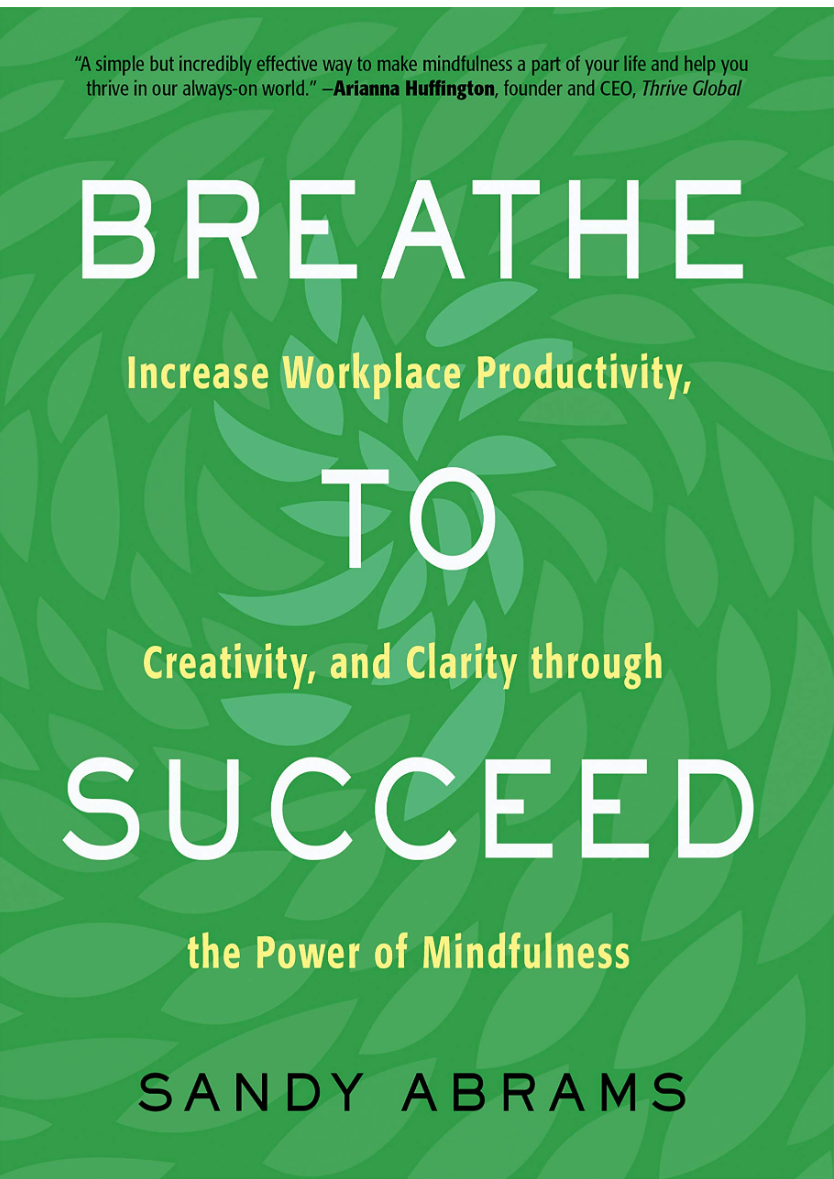INSIDER: Breathe to Succeed: Increase Workplace Productivity, Creativity, and Clarity through the Power of Mindfulness
Corrie A. H. Penraat, MBA Candidate
 In today’s real estate environment, it isn’t often you get a chance to just be still and breathe. The demands of multitasking and meeting deadlines under extreme pressure never seem to stop. We operate in a constant state of low-grade emergency immersed in technology that makes it nearly impossible to escape daily tension and strain. Rarely do we physically dispel stress hormones and take the time to resolve the underlying problem or stop to question our priorities.
In today’s real estate environment, it isn’t often you get a chance to just be still and breathe. The demands of multitasking and meeting deadlines under extreme pressure never seem to stop. We operate in a constant state of low-grade emergency immersed in technology that makes it nearly impossible to escape daily tension and strain. Rarely do we physically dispel stress hormones and take the time to resolve the underlying problem or stop to question our priorities.
In Sandy Abrams’ “Breathe to Succeed: Increase Workplace Productivity, Creativity, and Clarity through the Power of Mindfulness,” we learn how breath, self-awareness, and small changes in our daily routine can be a big part of our overall individual wellness solution, which can, in turn, lead to increased creativity, positivity, and productivity.
THINK POINT #1: Breathe
Oddly enough, findings show that the method in which we breathe in can act as a remote control for our brains. By breathing in through our nose, we indirectly control the signals of our memory and emotional brain centers. In this way, we can control and optimize brain function using our in-breath to have faster, more accurate emotional discernment and recognition, as well as gain better memory.
Breath is the catalyst that will begin to change the way you reach your goals. You’ll communicate with your brain and instruct it to help your mind and body think and feel in the way that will lead to expansion—more success, more opportunity, and more balance. Patience, persistence, confidence, nonjudgmental behavior, clarity, creativity, and compassion are easily accessible through conscious in-breath techniques and will help tremendously in real estate.
Abrams advocates for the three deep breaths—or 3DB—breathing pattern. 3DB is an easy way to experience the power of your breath and the freedom and strength it brings. Take a deep breath in, and as you inhale bring in something positive. Breathe out, and let go of what’s holding you back with every exhale. As you upgrade your breath from shallow to deep breathing patterns, you will begin to control your energy by connecting to the corresponding part of your brain that regulates emotion.Try using some of these “breath multipliers:”
- Act as if: You don’t have to feel brave to be brave. Act as if you already are successful—if your mind says, “I am successful,” you can begin to mentally and physically believe that you are, in fact, successful. Your body will feel that good energy when your mind tells it to.
- Close your eyes: Quickly reconnect your mind and body. Inspiration may be more likely to strike when we close our eyes—it’s like shutting a virtual door to the everything outside your body.
- Visualization: Visualize what success would look like during breathing routines. Taking thoughts to the next level is a detailed and experiential way of thinking positive.
- Mantras: Use phrases such as “I am… successful, capable, mindful leader, skilled real estate agent” while breathing in. Challenge yourself to say these out loud.
Remember that forming habits takes time, you may not notice the effects of breath right away.
THINK POINT #2: Self Awareness
Self-awareness, one of the rarest of human commodities, begins by understanding who you really are and discovering (and accepting) your personality traits, mental habits, and patterns. It is also critical to recognize when and where you tend to be weak or negative so that you’ll know exactly when and where to add positive reinforcement through breath. Become an observer of your own thoughts, behaviors, and energy. We all know the best version of ourselves that often gets pushed away in order to focus on work. The goal is to be our best selves even when things get crazy. When we see ourselves clearly, we are more confident and more creative.
When you learn how to be self-aware and upgrade your breath, you’ll make mindful business decisions rather than hasty ones. Tap into creativity instead of just working from random or mediocre ideas. Letting negative dialogue drive your decisions is a dangerous daily practice that will inevitably lead you in the wrong direction, and on top of that, your stress continues to simmer. Manage your negative thoughts, because you can’t afford the luxury of a negativity.
Start your journey of self-awareness with a personality test such as Myers-Briggs or the enneagram. Remember, this is a process! Self-awareness grows faster each time you use it and becomes embedded in your mind as a new habit. Check-in—stop, be still, close your eyes, take three deep breaths, and scan your body for stress. Program your phone to receive a reminder to check in or get into the habit of checking in while completing other activities such as eating, drinking water, walking to the restroom, or driving to your next client while opting for silence instead of turning on the car radio.
THINK POINT #3: Daily Routines
 Morning Rituals: Gain momentum from starting your day off right with stretches and breath work. Consider using aromatherapy during this time—citrus, rosemary, mint, lavender, and white sage are just a few beneficial essential oils. Do your most difficult tasks first to avoid the dread that comes with carrying them throughout your day. In our peak morning phase, it is best to focus on analytic work that requires more focus, attention, and vigilance. Studies show that what you eat and drink in the morning immediately affects your brain as you begin your day, and the brain is the most easily damaged organ by poor food and drink choices. Thus, Abrams suggests paying close attention to food and beverage choices during the morning hours.
Morning Rituals: Gain momentum from starting your day off right with stretches and breath work. Consider using aromatherapy during this time—citrus, rosemary, mint, lavender, and white sage are just a few beneficial essential oils. Do your most difficult tasks first to avoid the dread that comes with carrying them throughout your day. In our peak morning phase, it is best to focus on analytic work that requires more focus, attention, and vigilance. Studies show that what you eat and drink in the morning immediately affects your brain as you begin your day, and the brain is the most easily damaged organ by poor food and drink choices. Thus, Abrams suggests paying close attention to food and beverage choices during the morning hours.
Technology: Are you being negatively affected by your screen time? Research shows we are experiencing a false sense of productivity with reflex check-ins—reading emails or answering texts—and subjecting ourselves to constant low-grade stress. Become self-aware of these habits. We prevent the learning process with constant brain stimulation. It is in moments of idleness that we produce our most creative ideas, so give your mind space and allow it to wander. Abrams challenges readers to take a walk without a cell phone, buy a paper book, set aside lunch time as unplugged, and to turn off cell phones at least two hours before bed. Challenge yourself to build relationships rather than rack up transactional encounters. Nurturing relationships is a big part of success in real estate, and it will require effort. Put your phone away when talking to clients and give them your full attention. You may be surprised at the results.
Conclusion
Bringing breath into real estate helps manage negatives emotions by letting them go with each deep exhale—thereby breathing in confidence, optimism, and a higher level of patience with each inhale. Abrams explains that by implementing these techniques, she grew stronger emotionally, which gave her a new sense of physical energy as she chose positive thoughts, achieving milestones faster than she imagined.
. . . . . . . . . . . . . . . . . . .
Recommended Reading
Abrams, Sandy (2019), Breathe to Succeed: Increase Workplace Productivity, Creativity, and Clarity through the Power of Mindfulness, Career Press: Newburyport, MA.
. . . . . . . . . . . . . . . . . . .
About the Author
Corrie A. H. Penraat, MBA Candidate
Baylor University
Corrie earned her Bachelor of Science in International Business from Grove City College. Her past work experience includes roles for non-profits such as World Vision and Samaritan’s Purse. Corrie is currently pursuing an MBA with a certification in Data Analytics at Baylor University and plans to further her career within supply chain management.